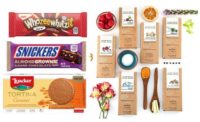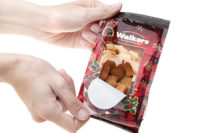Candy Sales Are In The Bag
By Paul Waldron, Gladson Interactive
Peg-packaged products deliver benefits for shoppers
and retailers.
Peg candy has
come a long way from just being an avenue for making use of untapped space
in the candy department. Today peg candies are helping to drive overall
candy volume, which rose 3 percent from $6.87 billion to $7 billion for the
52-week period ended April 22, 2006, according to ACNielsen data for food,
drug and mass merchandisers, excluding Wal-Mart. Retailers report peg candy
sales — both rebagged and peg-packaged vertical lines from branded
candy companies — are on the increase for the following reasons.
They offer attractive entry prices that entice
shoppers, especially those pinching pennies against rising grocery and gas
prices. The small bags can be sold at 2 for $1 or single items for 99
cents. A survey by this publication earlier this year revealed that 62.4
percent of those polled offer 2 for $1 candies and 58.8 percent have 99
cent offers (respondents were asked to indicate all price points that
applied).
Customers looking for sugar-free products prefer
the convenience of bagged candy. Peg products are now plan-o-grammed with
the same merchandising savvy of traditional candy sets.
The programs work well for either private label
or national brands. Buyers say they are quick to take on proven new candies
in bag form. In tune with that trend, manufacturers are rolling out
peg bag versions of branded candies sooner after the rollout of the
original branded SKUs.
Peg programs offer high margins in what is often
unused or under-used merchandise space.
Attractive pricing. Dollar
stores are gaining in sales of candy products, including bagged items. One
president of an extra-value chain said candy was among his top three
categories. “We have people come here before a movie and stock up.
Why would you pay the prices at a movie?” he questioned.
The drive for value at dollar stores has raised
awareness in general, and shoppers pressed with rising gas costs are
looking to pinch pennies. Also, retailers are adding more dollar sections.
Pegged candy offers the opportunity to sell candy at 99 cents or multiple
bags for $2 or less. There can even be a $1 bagged candy section within the
peg area. Despite consumers’ love of bargains, retailers interviewed
said they are adding more upscale rebagged candy to trade shoppers up
closer to a $3 price tag. So although value rules in peg candies, there are
indications that retailers are also trying to move shoppers up.
Diabetic or sugar-free candies. Chocolate dietetic candy sales are down,
but non-chocolate are on the rise. The non-chocolate segment dominates peg
candy, and that suggests growth and more opportunity for sugar-free in the
peg category. People who need to purchase these items prefer a handy
package they can take in lunches or snack on at one time. The sugar-free
peg selection needs its own home in plan-o-grams with clear signage so
shoppers can find it quickly.
At this point retailers report that sugar-free or
low-carb is primarily driven by well-known brands vs. private labels.
However, once trained to like something, shoppers appear willing to try
private labels, buyers said. Sugar-free products are perfect for cross
merchandising in a multitude of other store locales such as the diet foods
area, the pharmacy and the exercise products aisle.
Peg plan-o-grams. When
peg programs first burst onto the market, retailers used wall space over
shelves that couldn’t be merchandised with traditional box candy or
bars. Often a rack-jobber simply put any candy in any spot.
Now the same science used in the entire candy
department is applied to maximizing peg sales. There are sub-segments
within peg candy that must be allocated the proper space. For example,
there are dietetic candies, small snack SKUs that often come from companies
that might be described as a hybrid of snack/candy company, branded
programs and private labels. Each peg area has its own shopper profile and
needs to have clear delineation on the peg wall.
Plan-o-gramming can be specific to stores, too. Most
retailers have a firm handle on whether each store within the portfolio
serves a young, family-oriented clientele, or a more mature audience. Fun
bag candy can have a larger presence in stores with kids; old-fashioned
hard candies might hit a chord in an area where the population skews more
heavily toward older consumers.
Sugar-free works in both environments, since people of
all ages require these special candies. The same is true for nostalgia
candy.
Secondary locations are perfect for peg candy. Candy
targeted to dieters and/or diabetics can go in a diet section or near the
pharmacy. Sours and shapes are suitable for a toy department. Candy is even
pretty with a spinner in cosmetics since so many colors and cosmetics these
days are inspired by candy.
National brand vs. private label. Interviews with retailers reveal peg programs work well in both
instances. One major drug chain, for example, took the majority of its peg
candy program private label. The president of the chain said he liked being
able to control the size of the bag to make optimal use of space in the
category. He did admit, however, that it is hard for a retailer to be on
top of emerging candy trends.
Many retailers said one of the unique aspects of candy
is that private label and control labels exist comfortably side-by-side
— much like a branded shampoo with a store equivalent. For some, this
represents an opportunity to extend the private label offering.
Retailers also noted that peg programs are not
cannibalized by the existence of bag-your-own areas, which are on the
upswing once again, led by major retailers merchandising these areas as if
they were new fashions. “One need only look at what Target has done
in candy,” said Wendy Liebmann, founder of WSL Strategic Retail.
“They’ve applied the same approach to candy as they have to
fashion. You can’t help but buy it,” she said of the self-serve
area. However, Target maintains a peg program as well.
Margins. As with many
categories, small sizes often yield a few extra points in gross margin.
With peg, the prospects are even better since there are sweet margins and
rapid turns. What is also attractive, said one leading supplier, is that
there are not as many seasonal swings to peg programs, yet shoppers are
willing to opt for limited editions when offered. “That
represents a win-win situation,” he added.
In conclusion, peg programs are stronger than ever,
but must be managed from a merchandising standpoint with the same savvy and
market knowledge as the rest of the department. That hasn’t always
been the case, but as retailers look to maximize every square inch of
sales, those tiny bags present sweet opportunities.





